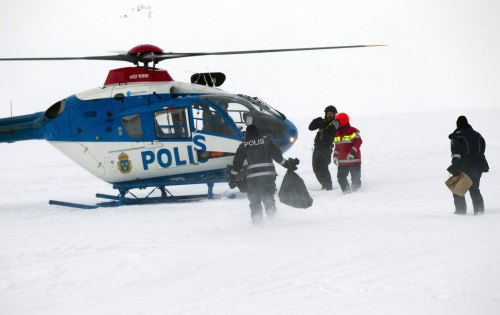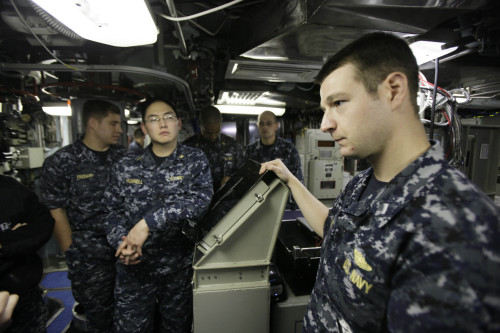
To the world’s military leaders, the debate over climate change is long over. They are preparing for a new kind of Cold War in the Arctic, anticipating that rising temperatures there will open up a treasure trove of resources, long-dreamed-of sea lanes and a slew of potential conflicts.
By Arctic standards, the region is already buzzing with military activity, and experts believe that will increase significantly in the years ahead.

Last month, Norway wrapped up one of the largest Arctic maneuvers ever _ Exercise Cold Response _ with 16,300 troops from 14 countries training on the ice for everything from high intensity warfare to terror threats. Attesting to the harsh conditions, five Norwegian troops were killed when their C-130 Hercules aircraft crashed near the summit of Kebnekaise, Sweden’s highest mountain.
The U.S., Canada and Denmark held major exercises two months ago, and in an unprecedented move, the military chiefs of the eight main Arctic powers _ Canada, the U.S., Russia, Iceland, Denmark, Sweden, Norway and Finland _ gathered at a Canadian military base last week to specifically discuss regional security issues.
None of this means a shooting war is likely at the North Pole any time soon. But as the number of workers and ships increases in the High North to exploit oil and gas reserves, so will the need for policing, border patrols and _ if push comes to shove _ military muscle to enforce rival claims.
The U.S. Geological Survey estimates that 13 percent of the world’s undiscovered oil and 30 percent of its untapped natural gas is in the Arctic. Shipping lanes could be regularly open across the Arctic by 2030 as rising temperatures continue to melt the sea ice, according to a National Research Council analysis commissioned by the U.S. Navy last year.
What countries should do about climate change remains a heated political debate. But that has not stopped north-looking militaries from moving ahead with strategies that assume current trends will continue.
Russia, Canada and the United States have the biggest stakes in the Arctic. With its military budget stretched thin by Iraq, Afghanistan and more pressing issues elsewhere, the United States has been something of a reluctant northern power, though its nuclear-powered submarine fleet, which can navigate for months underwater and below the ice cap, remains second to none.
Russia _ one-third of which lies within the Arctic Circle _ has been the most aggressive in establishing itself as the emerging region’s superpower.
Rob Huebert, an associate political science professor at the University of Calgary in Canada, said Russia has recovered enough from its economic troubles of the 1990s to significantly rebuild its Arctic military capabilities, which were a key to the overall Cold War strategy of the Soviet Union, and has increased its bomber patrols and submarine activity.
He said that has in turn led other Arctic countries _ Norway, Denmark and Canada _ to resume regional military exercises that they had abandoned or cut back on after the Soviet collapse. Even non-Arctic nations such as France have expressed interest in deploying their militaries to the Arctic.
“We have an entire ocean region that had previously been closed to the world now opening up,’’ Huebert said. “There are numerous factors now coming together that are mutually reinforcing themselves, causing a buildup of military capabilities in the region. This is only going to increase as time goes on.’’
Noting that the Arctic is warming twice as fast as the rest of the globe, the U.S. Navy in 2009 announced a beefed-up Arctic Roadmap by its own task force on climate change that called for a three-stage strategy to increase readiness, build cooperative relations with Arctic nations and identify areas of potential conflict.
“We want to maintain our edge up there,’’ said Cmdr. Ian Johnson, the captain of the USS Connecticut, which is one of the U.S. Navy’s most Arctic-capable nuclear submarines and was deployed to the North Pole last year. “Our interest in the Arctic has never really waned. It remains very important.’’

But the U.S. remains ill-equipped for large-scale Arctic missions, according to a simulation conducted by the U.S. Naval War College. A summary released last month found the Navy is “inadequately prepared to conduct sustained maritime operations in the Arctic’’ because it lacks ships able to operate in or near Arctic ice, support facilities and adequate communications.
“The findings indicate the Navy is entering a new realm in the Arctic,’’ said Walter Berbrick, a War College professor who participated in the simulation. “Instead of other nations relying on the U.S. Navy for capabilities and resources, sustained operations in the Arctic region will require the Navy to rely on other nations for capabilities and resources.’’
He added that although the U.S. nuclear submarine fleet is a major asset, the Navy has severe gaps elsewhere _ it doesn’t have any icebreakers, for example. The only one in operation belongs to the Coast Guard. The U.S. is currently mulling whether to add more icebreakers.
Acknowledging the need to keep apace in the Arctic, the United States is pouring funds into figuring out what climate change will bring, and has been working closely with the scientific community to calibrate its response.
“The Navy seems to be very on board regarding the reality of climate change and the especially large changes we are seeing in the Arctic,’’ said Mark C. Serreze, director of the National Snow and Ice Data Center at the Cooperative Institute for Research in Environmental Sciences University of Colorado. “There is already considerable collaboration between the Navy and civilian scientists and I see this collaboration growing in the future.’’
The most immediate challenge may not be war _ both military and commercial assets are sparse enough to give all countries elbow room for a while _ but whether militaries can respond to a disaster.
Heather Conley, director of the Europe program at the London-based Center for Strategic and International Studies, said militaries probably will have to rescue their own citizens in the Arctic before any confrontations arise there.
“Catastrophic events, like a cruise ship suddenly sinking or an environmental accident related to the region’s oil and gas exploration, would have a profound impact in the Arctic,’’ she said. “The risk is not militarization; it is the lack of capabilities while economic development and human activity dramatically increases that is the real risk.’’ (AP)
<한글 기사>
북극, 빙하녹으면서 ‘新냉전’ 휘말려
세계 주요 군(軍)지도자들에게 지구온난화 논란은 이미 끝난 지 오래다. 그들은 북극에서 벌어질 새로운 ‘냉전’(冷戰)을 예상하고, 대비중이다.
북극의 빙하가 녹으면서 자원의 보고와 오랫동안 기다려왔던 해로가 열리고, 이와함께 적지 않은 갈등과 분쟁이 등장할 것이기 때문이다.
미국 지질조사연구소에 따르면 세계 미탐색 원유의 13%, 미개발 천연가스의 30%가 북극에 묻혀있다.
지금까지 얼어있던 북극 바다는 지구온난화가 현재의 추세를 계속하면 2030년쯤에는 정기 해로가 열릴 전망이다.
북극을 둘러싼 세계 각국의 군사적 ‘신경전’은 이미 시작됐다.
지난달 노르웨이는 북극에서 벌어진 군사작전으로는 사상 최대 규모에 속하는 ‘냉정한 대응’(Cold Response) 훈련을 끝냈다. 14개국에서 1만6천300명이 참여해 빙판 위에서 전투, 테러 대응 등 모든 종류의 군사훈련을 실시했다.
훈련중 허큘리스 C-130의 추락으로 이 수송기에 타고 있던 노르웨이 병사 5명이 숨진 것은 이 훈련이 얼마나 험난했던 것인가를 말해준다.
미국, 캐나다, 덴마크는 이에 앞서 두달전 북극에서 대규모 군사훈련을 실시했다.
또 미국, 러시아, 아이슬란드, 덴마크, 스웨덴, 노르웨이, 핀란드, 캐나다 등 북극 주변 8개국의 군 사령관들은 지난주 캐나다 기지에 모여 전례없이 북극 지역안보 문제를 논의했다.
물론 이런 움직임들이 북극에서 조만간 전쟁이 일어날 것이라는 것을 의미하지는 않는다.
북극에서 석유•가스 탐사 개발 등으로 근로자들의 활동과 선박의 왕래가 잦아지면 순찰, 국경 감시도 함께 증가하고, 경쟁국간의 마찰은 군사적 긴장으로 이어질 수 있다는 것이다.
북극권 국가가 아닌 프랑스조차 북극에 자국군을 배치할 수 있는지에 관심을 보이고 있다.
북극에 가장 많은 영토를 보유하고 있는 나라는 러시아, 캐나다, 미국이며, 이 중 러시아는 영토의 3분의1이 북극권에 속한다.
러시아는 북극의 ‘슈퍼파워’로 거듭나기 위해 안간힘을 쓰고 있다. 노르웨이, 덴마크, 캐나다 등이 북극에서 군사훈련을 재개한 것은 러시아의 이런 공세와 무관하지 않다.
미국은 북극 빙하가 녹는 속도가 지구의 다른 지역에 비해 2배에 달한다는 것에 주목하고 2009년 훨씬 강화된 ‘북극 로드맵’을 만들었다.
미국 지구온난화 대응팀이 만든 이 로드맵은 북극 빙하가 녹는 데 대한 준비활동, 북극권 국가들과의 협력을 강화하고, 잠재적인 분쟁지역을 찾아내는 게 목적이다.
북극에서 수행할 수 있는 작전력을 보유한 핵잠수함 커네티컷호의 이안 존슨 사령관은 “북극지역에서 미군은 우세를 계속 유지할 것”이라며 “북극에 대한 우리 관심은 결코 식지 않았으며, 북극의 중요성은 지속될 것”이라고 강조했다.
그러나 미해군 역시 아직까지 북극에서 큰 군사 작전을 지속적으로 펴는 데 충분한 군함, 통신시설, 장비를 갖추지 못하고 있다.
일례로 미해군은 쇄빙선을 한척도 보유하지 못하고 있으며 이는 해안경비대에 소속돼 있을 뿐이다.
미 해군은 ‘북극해 작전’을 상정했을 때의 미비점을 확인하고 빠른 속도로 이를 보완하고 있다.
런던 소재 국제전략문제연구소의 헤더 콘리 박사는 군사적 갈등이 가시화되지 않더라도 군대가 북극에서 활동할 수 있는 능력을 갖추는 게 필요하다고 지적했다.
콘리 박사는 “크루즈선이 침몰하거나 석유개발과 관련된 환경재난이 발생하면 군대가 구조에 나서야 할 것”이라며 “북극의 군사화가 아니라 경제개발과 인간활동증가에도 불구하고 이로 인한 만일의 사태에 대응할 수 있는 능력의 부재가 문제”라고강조했다. (연합뉴스)
북극, 빙하녹으면서 ‘新냉전’ 휘말려
세계 주요 군(軍)지도자들에게 지구온난화 논란은 이미 끝난 지 오래다. 그들은 북극에서 벌어질 새로운 ‘냉전’(冷戰)을 예상하고, 대비중이다.
북극의 빙하가 녹으면서 자원의 보고와 오랫동안 기다려왔던 해로가 열리고, 이와함께 적지 않은 갈등과 분쟁이 등장할 것이기 때문이다.
미국 지질조사연구소에 따르면 세계 미탐색 원유의 13%, 미개발 천연가스의 30%가 북극에 묻혀있다.
지금까지 얼어있던 북극 바다는 지구온난화가 현재의 추세를 계속하면 2030년쯤에는 정기 해로가 열릴 전망이다.
북극을 둘러싼 세계 각국의 군사적 ‘신경전’은 이미 시작됐다.
지난달 노르웨이는 북극에서 벌어진 군사작전으로는 사상 최대 규모에 속하는 ‘냉정한 대응’(Cold Response) 훈련을 끝냈다. 14개국에서 1만6천300명이 참여해 빙판 위에서 전투, 테러 대응 등 모든 종류의 군사훈련을 실시했다.
훈련중 허큘리스 C-130의 추락으로 이 수송기에 타고 있던 노르웨이 병사 5명이 숨진 것은 이 훈련이 얼마나 험난했던 것인가를 말해준다.
미국, 캐나다, 덴마크는 이에 앞서 두달전 북극에서 대규모 군사훈련을 실시했다.
또 미국, 러시아, 아이슬란드, 덴마크, 스웨덴, 노르웨이, 핀란드, 캐나다 등 북극 주변 8개국의 군 사령관들은 지난주 캐나다 기지에 모여 전례없이 북극 지역안보 문제를 논의했다.
물론 이런 움직임들이 북극에서 조만간 전쟁이 일어날 것이라는 것을 의미하지는 않는다.
북극에서 석유•가스 탐사 개발 등으로 근로자들의 활동과 선박의 왕래가 잦아지면 순찰, 국경 감시도 함께 증가하고, 경쟁국간의 마찰은 군사적 긴장으로 이어질 수 있다는 것이다.
북극권 국가가 아닌 프랑스조차 북극에 자국군을 배치할 수 있는지에 관심을 보이고 있다.
북극에 가장 많은 영토를 보유하고 있는 나라는 러시아, 캐나다, 미국이며, 이 중 러시아는 영토의 3분의1이 북극권에 속한다.
러시아는 북극의 ‘슈퍼파워’로 거듭나기 위해 안간힘을 쓰고 있다. 노르웨이, 덴마크, 캐나다 등이 북극에서 군사훈련을 재개한 것은 러시아의 이런 공세와 무관하지 않다.
미국은 북극 빙하가 녹는 속도가 지구의 다른 지역에 비해 2배에 달한다는 것에 주목하고 2009년 훨씬 강화된 ‘북극 로드맵’을 만들었다.
미국 지구온난화 대응팀이 만든 이 로드맵은 북극 빙하가 녹는 데 대한 준비활동, 북극권 국가들과의 협력을 강화하고, 잠재적인 분쟁지역을 찾아내는 게 목적이다.
북극에서 수행할 수 있는 작전력을 보유한 핵잠수함 커네티컷호의 이안 존슨 사령관은 “북극지역에서 미군은 우세를 계속 유지할 것”이라며 “북극에 대한 우리 관심은 결코 식지 않았으며, 북극의 중요성은 지속될 것”이라고 강조했다.
그러나 미해군 역시 아직까지 북극에서 큰 군사 작전을 지속적으로 펴는 데 충분한 군함, 통신시설, 장비를 갖추지 못하고 있다.
일례로 미해군은 쇄빙선을 한척도 보유하지 못하고 있으며 이는 해안경비대에 소속돼 있을 뿐이다.
미 해군은 ‘북극해 작전’을 상정했을 때의 미비점을 확인하고 빠른 속도로 이를 보완하고 있다.
런던 소재 국제전략문제연구소의 헤더 콘리 박사는 군사적 갈등이 가시화되지 않더라도 군대가 북극에서 활동할 수 있는 능력을 갖추는 게 필요하다고 지적했다.
콘리 박사는 “크루즈선이 침몰하거나 석유개발과 관련된 환경재난이 발생하면 군대가 구조에 나서야 할 것”이라며 “북극의 군사화가 아니라 경제개발과 인간활동증가에도 불구하고 이로 인한 만일의 사태에 대응할 수 있는 능력의 부재가 문제”라고강조했다. (연합뉴스)











![[From the Scene] Monks, Buddhists hail return of remains of Buddhas](http://res.heraldm.com/phpwas/restmb_idxmake.php?idx=644&simg=/content/image/2024/04/19/20240419050617_0.jpg&u=20240419175937)



![[From the Scene] Monks, Buddhists hail return of remains of Buddhas](http://res.heraldm.com/phpwas/restmb_idxmake.php?idx=652&simg=/content/image/2024/04/19/20240419050617_0.jpg&u=20240419175937)

![[KH Explains] Hyundai's full hybrid edge to pay off amid slow transition to pure EVs](http://res.heraldm.com/phpwas/restmb_idxmake.php?idx=652&simg=/content/image/2024/04/18/20240418050645_0.jpg&u=20240419100350)

![[Today’s K-pop] Illit drops debut single remix](http://res.heraldm.com/phpwas/restmb_idxmake.php?idx=642&simg=/content/image/2024/04/19/20240419050612_0.jpg&u=)